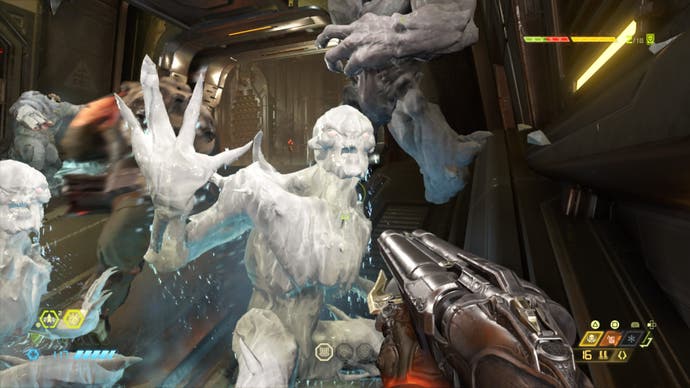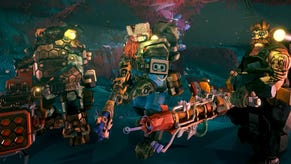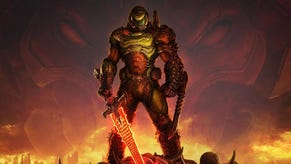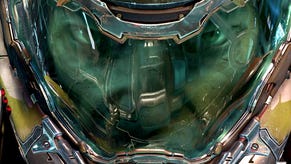Doom Eternal review - the same orgiastic thrills with a creeping weight of story
Groundhog slay.
"Story in a game is like a story in a porn movie," the original Doom's programmer John Carmack once wrote. "It's expected to be there, but it's not that important." A connoisseur of sleaze might object that story often makes for sexier porn - after all, story tends to involve chemistry, atmosphere, suspense and all the other emotions that distinguish intimacy from the act of banging together genitals to spark a human being. Still, if we're going to liken games to pornography, and assuming it's the more kinetic kind of pornography you're after, I heartily recommend Doom Eternal: a looping video compilation of oversized guns and fists plunging into squelchy orifices, spurting along at 60 frames a second.
2016's accomplished reboot was already quite the debauch, its firefights punctuated by leering close-ups of skewered hellspawn, its heavy metal soundtrack always building to a crescendo. Eternal turns up the heat even further, allowing you to dash and flip your way around arenas that are newly fixated on the vertical axis. Dripping organs are wrenched out of, then stuffed back into, demon torsos; chargeable alt-fires scream for release; health orbs spatter the ramps and chokepoints like - well, you get the picture. The environments often look like the work of an adolescent H.R. Giger who's just got into AC/DC. Aside from silvery Protoss-ish fortresses and some seriously down-at-heel office blocks, you'll wander labyrinths of squirming flesh, using runes to unclench toothy sphincters and shearing pop-up tentacles in half with your shotgun.

Some, of course, will soberly insist that all of this is just good, honest, videogame violence - clean, upstanding fun with absolutely no over- or undertones whatsoever. And to these people I say: when I am walking down the shaft of an enormous spear, straight into the pierced belly of a reeling, gaping titan, it is difficult to argue that there isn't some kind of metaphor in play. "Rip and tear"? More like rip and splooge.
Carmack's porn quote (which he has since qualified a little) epitomises the view that narrative in games is always an imposition, a foreign body carried over from film and literature. It's a view that has been roundly debunked. The thing is, though, Eternal does have a story, somewhere in amongst the parade of demon O-faces, and while that story is lightweight by Zenimax game standards, it feels hopelessly grafted on. Having thwarted Hell's invasion of Mars, the legendary Doom Slayer must purge Earth itself of diabolical interlopers, setting out from a gothic orbital station turned customisation hub to a series of ravaged cities, factories and temples that feel on loan from Gears of War. In the process, he must also tunnel back into a startlingly eventful past, sitting through flashbacks and wrangling with old allies.
The 2016 game was a thrilling reimagining of the speed and ferocity of 90s Doom combat, but it also magnified Doom's narrative trappings, adding in cutscenes, audio diaries, codex entries and mid-mission dialogue - a curious reversal of one of id's key decisions with the original game, which was once planned to include a sizeable narrative component written by co-founder Tom Hall. Eternal adds yet more to the load, expanding the cast and redoubling the emphasis on lore.
The cutscenes are now a mix of first and third-person, which means the Slayer is a fully tangible human being - one you can, moreover, trick out with unlockable outfits and weapon skins - rather than a pair of enormous fists twitching beneath your aiming reticle. He feels enclosed by the fiction, rather than, as Christian Donlan put it back in the day, like a man who is also playing Doom and who shares your resentment for anything that gets in the way. There's some effort to explain the character's superhuman prowess, with one scientist suggesting that you represent humanity's rage to survive, as opposed to humanity's love of making Cacodemons pop in slow motion. The Slayer even has a voice these days, though I think he strings together maybe five words in total.
True, our man in green never looks happy with all the attention, stomping impatiently through cinematics while other parties monologue at his retreating head (if they're lucky, that is - the fate of most speaking roles in Eternal is to be ground up like tuna). Nor are you required to listen to the audio diaries, or dip into the codex. But these elements drag on you nonetheless, like the lakes of purple goop that stop you running or jumping in certain levels. They're a deflating reminder that you are no longer here just to indulge your baser instincts. Conversely, the developer's guilty awareness that people don't play Doom for the narrative means that when you do dig into the world-building, you'll find it to be scanty and by-the-numbers: a set of tired references to ancient races, legendary battles and fallen cities.
Still, if visceral gratification is the goal, Eternal amply delivers. The combat is once again about ceaseless pivoting between attack and retreat, care of a raucous battlefield ecology which sees you ripping ammo, health and armour refills from your prey rather than just searching for medikits or finding somewhere to cool off. Stun a foe and you can execute them for a smidgeon of health. These executions double as windows of rest, with other demons easing off till you're done rearranging your victim's anatomy. They can also be triggered from metres away, warping you to the target without even the courtesy of a transitional animation, which means you can use them to escape or get behind a mob. Bisect demons with your trusty chainsaw, meanwhile, and you'll be rewarded with a geyser of ammo, restocking all your weapons in one dollop. You'll need plenty of chainsaw fuel to carve up the bigger demons, but you'll always have enough to carve up the smaller "fodder" demons, who spawn endlessly throughout each battle till the larger demons are slain.

This hyper-aggressive resourcing style forces you to close the gap with foes who are, in any case, very good at running you down. Some, like the minion-summoning Archville, are closer to terrain hazards, but the underworld's legions are light on snipers or artillery; pretty much everybody, from the podgy Mancubus to the serpentine Whiplash, is hell-bent on getting in your face. It sounds like chaos, and often is, but there's a lot of science to Eternal's combat, and solid artistry to how the key variables are conveyed from second to second. Ammo, health and armour drops are colour-coded; staggered enemies flash blue, then orange when you're within striking distance. The game's audio is similarly readable, once you acclimatise to the roaring heavy metal soundtrack. You'll learn to follow the progress of the battle by ear - be it the tink of a cooldown gauge, the belch of a Cacodemon that has just swallowed something explosive, teeing it up for an execution, or the nasal howl of a charging Pinky.
New variables include an ice grenade, mapped to the trigger, which lets you flash-freeze whole groups to interrupt otherwise lethal offensives. You can also light foes up with your shoulder flamethrower attachment, causing them to spit out armour parts and further motivating you to fight at close quarters when you're hurting. The most important change-up, however, is your newfound agility. Besides availing himself of launchpads, the Slayer can now perform aerial dashes, scuttle up laddered surfaces, swing from monkey bars and use a Super Shotgun-mounted grapple line to yank himself towards or past enemies.
This encourages showboating reminiscent of anti-gravity duels in the sadly-forgotten Lawbreakers. You might grapple somebody, fling yourself past them while firing your shotgun pointblank, then double-jump to a monkey bar, hurling yourself at a stunned Pain Elemental, then drop neatly onto a launchpad while switching to your Heavy Assault Rifle so that you can carpet the arena in micro-missiles. The weapons are by and large entertaining rejigs of Doom 2016's offerings, with two upgradeable alternate-fires per gun that lend themselves to different tactics and different opponents. Your shotgun, for instance, can serve as either a sticky grenade launcher - useful when trying to shoot the turret off a Cyberdemon - or a buckshot-firing Gatling gun for crowd control.

Inevitably, the charm of Eternal diminishes the further you travel from these firefights. Its grander story component aside, the game is slightly over-burdened with customisation systems. Besides tracking down weapon mods in levels themselves, you'll equip runes for perks such as slow-mo when you aim in mid-air, together with Praetor Suit upgrades such as the ability to suck in health drops from further away. There's a knack to combining Rune perks, especially when tackling "Master" versions of levels that have more punishing enemy spawn patterns, but the role-playing systems aren't novel, and the associated menu-diving bogs down a shooter that's at its best in the thick of the bloodshed.
What really saps Eternal, however, is the predictable way the campaign once again breaks down into combat bowls and platforming stretches that feel like they've been stripped at random from Prince of Persia: Sands of Time. There are collectibles to unearth, some tucked in high alcoves or behind smashable walls, together with optional hidden battle chambers, but the alternation of shoot-out then jumpy bit then shoot-out is the same throughout. Boss battles are the biggest change of tune - the final clash is a doozie, a gruelling two-phase affair in which your nemesis looms over the layout like the world's angriest D&D player. But some of them are just annoying, a question of repeating a tactic to whittle down a health-bar. It's revealing that the game offers you a layer of all-but-indestructible Sentinel armour after a certain number of deaths, though Eternal's accessibility is otherwise refreshing: dropping the difficulty doesn't cost you anything in terms of progress, and you revert to the previous difficulty once the bossfight is over.
It's worth remembering that old school Doom wasn't just a series of one-man massacres. It could be ominous and anxiety-inducing. It had monsters you could hear through walls, shambling about in the guts of the level, and concealed partitions that slid open without warning. It had a narrative, just about, but it didn't try to root the weirdness of its concept or spaces in lore, and its secrets were as much about enjoying the possibilities of virtual architecture as securing a power-up. It was a world of alarming corners and optical tricks that deformed and shifted simply because it could. For all its abundance of things to find, you don't get quite the same feeling in Doom Eternal. At times, it feels like the levels have been designed backwards from the completion screen, with its grocery lists of optional treasures and encounters. You might argue that 3D worlds are simply less surprising on the whole in 2020 than in 1993, but that's to ignore the work of countless Doom modders whose creations, made using id's original engine and tools, continue to startle and intrigue today.

The missing link in this review is multiplayer, which is offline for the moment, but which already looks like a step up from Doom 2016's ramshackle online. It's a strictly asymmetrical affair, with one player starring as the Slayer while the others control one of five demon breeds from the campaign. As a demon, you can summon AI-controlled hellspawn with the D-pad, so victory is presumably as much about mob strategy as dealing damage yourself. Which sounds like a pleasant way to cool off once you've tired of the sweaty embrace of a campaign that, for all its breaking of Carmack's ancient maxim, has a shot at being one of the best you'll play this year. Still, Doom Eternal leaves me undecided. The game is fundamentally the 2016 reboot again with new props, and its dogged commitment to Doom's narrative universe is as baffling as the firefights are exhilarating. Is this really all Doom can be, nowadays - a cascade of collectables, unwanted cutscenes and the spectacle of a gurning demon face, forever?

















